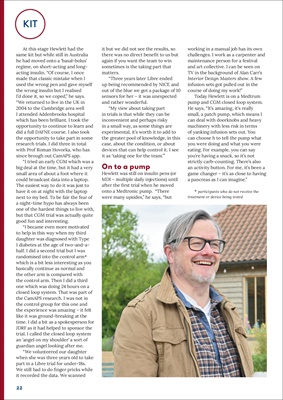
22KIT
there could be a misunderstanding."
At this stage Hewlett had the
same kit but while still in Australia
he had moved onto a 'basal-bolus'
regime, on short-acting and longacting
insulin. "Of course, I once
made that classic mistake when I
used the wrong pen and gave myself
the wrong insulin but I realised
I'd done it, so we coped," he says.
"We returned to live in the UK in
2004 to the Cambridge area well
I attended Adam brooks hospital
which has been brilliant. I took the
opportunity to continue to learn and
did a full DAFNE course. I also took
the opportunity to take part in some
research trials. I did three in all with
Prof Roman Hvorka, who has since
brough out CamAPS app.
"I tried an early CGM which was a
big deal at the time, but it had a very
small area of about a foot where it
could broadcast data into a laptop.
The easiest way to do it was just to
have it on at night with the laptop
next to my bed. To be fair the fear of
a night-time hypo has always been
one of the hardest things to live with,
but that CGM trial was actually quite
good fun and interesting.
"I became even more motivated
to help in this way when my third
daughter was diagnosed with Type
1 diabetes at the age of two-and-ahalf. I did a second
trial but I was
randomised into the control arm**
which is a bit less interesting as you
basically continue as normal and
the other arm is compared with
the control arm. Then I did a third
one which was doing 24 hours on a
closed loop system. That was part of
the CamAPS research. I was not in
the control group for this one and
the experience was amazing - it felt
like it was ground-breaking at the
time. I did a bit as a spokesperson for
JDRF as it had helped to sponsor the
trial. I called the closed loop system
an 'angel on my shoulder' a sort of
guardian angel looking after me.
"We volunteered our daughter
when she was three years old to take
part in a Libre trial for under-18s.
We still had to do finger pricks while
it recorded the data. We scanned
it but we did not see the results, so
there was no direct benefit to us but
again if you want the team to win
sometimes is the taking part that
matters.
"Three years later Libre ended
up being recommended by NICE and
out of the blue we got a package of 10
sensors for her - it was unexpected
and rather wonderful.
"My view about taking part
in trials is that while they can be
inconvenient and perhaps risky
in a small way, as some things are
experimental, it's worth it to add to
the greater pool of knowledge, in this
case, about the condition, or about
devices that can help control it. I see
it as 'taking one for the team.'"
On to a pump
Hewlett was still on insulin pens (or
MDI - multiple daily injections) until
after the first trial when he moved
onto a Medtronic pump. "There
were many upsides," he says, "but
working in a manual job has its own
challenges. I work as a carpenter and
maintenance person for a festival
and art collective. I can be seen on
TV in the background of Alan Carr's
Interior Design Masters show. A few
infusion sets got pulled out as I was
did my work!"
Today Hewlett is on a Medtrum
pump and CGM closed loop system.
He says, "It's amazing, it's really
small, a patch pump, which means I
can deal with doorknobs and heavy
machinery with less risk in terms
of yanking infusion sets out. You
can choose h to tell the pump what
you were doing and what you were
eating. For example, you can say
you're having a snack, so it's not
strictly carb-counting. There's also
an activity button. For me, it's been a
game changer - it's as close to having
a pancreas as I can imagine."